It has been said in several Meeple Mountain reviews that, these days, there are trick-taking games aplenty. This is not really surprising; it is a well understood mechanic, having been honed over decades via games like Spades and Hearts well before the modern renaissance of board gaming began. All of this is to say that, if a game is going to center on trick-taking, it will need to use that mechanic in service of something special if it plans to stick around for very long. To this end, these beauties have a few tricks up their sleeves (see what I did there?)!
Before we begin, however, there is one thing that needs to be said: These are two separate products (Tournament at Camelot and Tournament at Avalon – referred to as Camelot and Avalon from this point forward). They are, however, essentially, the same game. The first part of this review discusses Camelot (as it came first); the second part deals with Avalon and what it adds to the basic formula. Even though they are in two different boxes, a review of one is effectively a review of the other.

Camelot
The game comes with the following components:
- The Weapons deck
- Health cards
- Characters
- The Godsend deck
- Tokens
The Weapons deck is a five-suited deck of cards with ranks 1 through 15, making a total of 75 standard weapon cards. There are four basic suits (Arrows, Deception, Sorcery, and Swords), and then Alchemy, which is a wildcard suit. Some of the cards (four in each basic suit) are considered poisonous; these have a skull and crossbones, as well as a blood stain mark on them.
Additionally, there are five special cards (sorcerers): Merlin (×3), Sorcerer’s Apprentice (×2). The suit of these cards is wild (similar to Alchemy cards); the rank is also wild! The player assigns a rank (1-15) when the card is played.
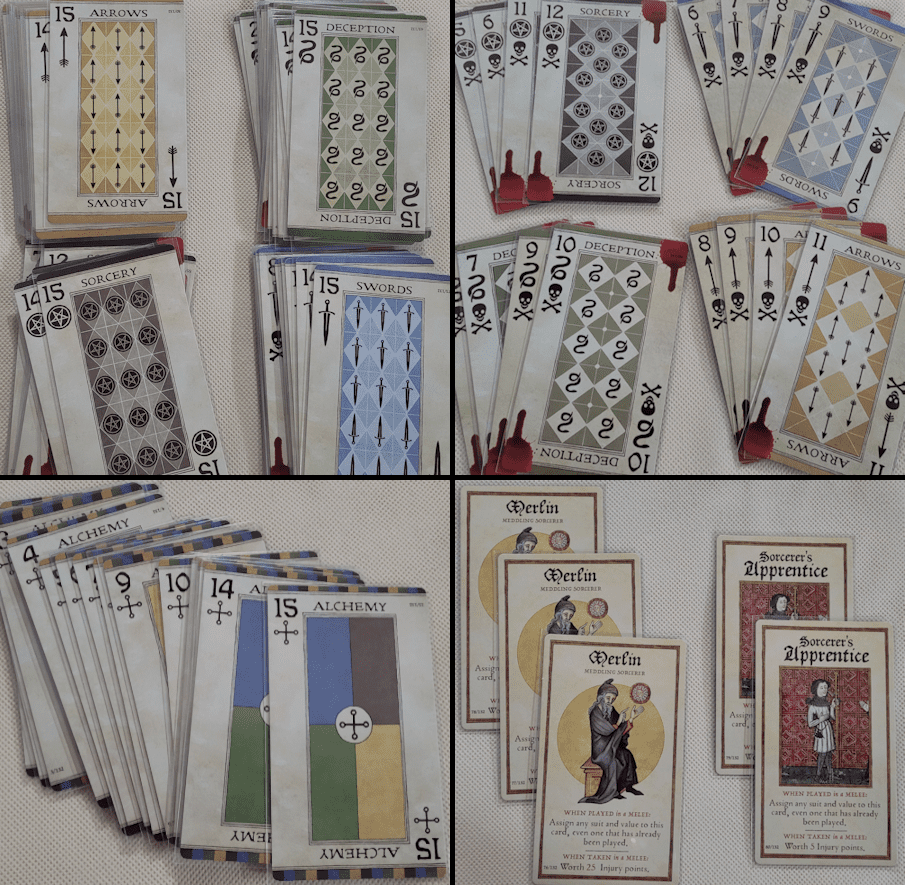
There are six sets of Health cards (the game is designed for 3-6 players). Each set consists of two double-sided cards used to track a player’s current health, in 5-point increments, from 400 points all the way down to 0.

There are eight protagonists and their companions that make up the Characters available. The protagonist chosen provides the player with a special ability at the start of the game. Their associated companion provides a special ability that becomes active once the player dips below a certain health point threshold.
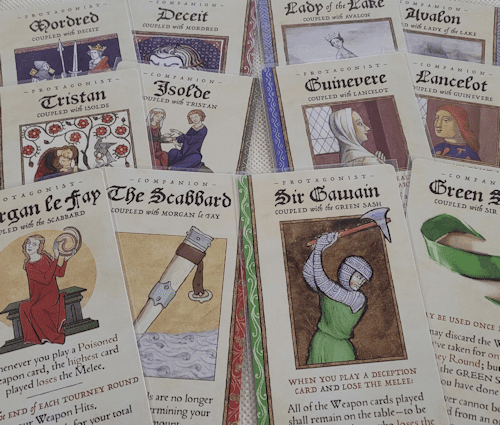
The Godsend deck consists of 24 cards. At the end of a hand of play (a “Tournament Round”), the player(s) with the lowest health scores receive divine aid in the form of Godsend cards. These are one-time use special powers that can be used in the next Tournament Round.
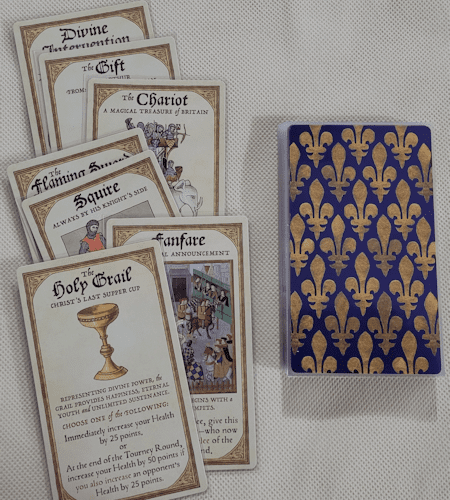
There are several tokens provided. All players receive a health token to keep track of their health points. Two of the Character cards (the Holy Knights and King Authur) have special tokens to indicate when their special abilities are being used.

Game Play
Each player starts with 400 health and a Character (chosen randomly or by the players). The protagonist card is placed over the companion, covering all the text except the health threshold value at the bottom.. The Godsend cards are shuffled and placed into a face-down deck near the play area. The Weapons deck is shuffled and a random player deals 12 cards to each player. The remaining cards are set aside as the draw deck. Protagonists and Godsend cards may allow a player to draw more cards. The Tournament Round is now ready!
Each round is made up of hands where each player plays a card into the center of the table; this is called a “melee.” The player to the left of the dealer plays the first card of the first melee of each round. The first card played in a melee sets the “lead suit” of that melee. In clockwise order, players play a card from their hand. They must play a card of the lead suit if they are able; sorcerer cards may always be played, if desired. If a player has no cards of the lead suit, they must play an Alchemy card instead. If they have no Alchemy cards, they discard a card from their hand (to the discard pile, not in the center of the table) and immediately suffer an injury (a loss of 5 health points) due to the shame of not being able to participate in the melee.
Once all players have either played a card into the melee or discarded a card in shame, the melee is over and it is time to determine who takes the cards. First flip over any cards that share the same rank; these cards represent feints in the melee and are not considered. Of the remaining cards, the player who played the lowest ranking card loses the melee and must take the cards (including any feints), placing them into their “weapon hits” pile. The player who took the cards will play the first card of the next melee.
A couple of notes before we continue:
- When a sorcerer is led, the player assigns a lead suit as desired (this can be Alchemy). When a sorcerer follows it is automatically assigned the lead suit. In either case, the rank must be assigned at the time the card is played.
- Alchemy cards can lead only if the player has no other suits in their hand. When Alchemy is the lead suit, players may follow in any suit, even if they have Alchemy cards in their hand.
- If all cards in the melee are flipped due to feints, nobody takes the cards. They remain in the middle of the table and are included as cards taken by the loser of the next melee.
- The lowest ranking face-up card loses the melee, no matter what suit that card happens to be.
Once all of the melees of the Tournament Round are complete, each player gathers the cards from their weapon hits pile and assesses how many injuries they suffered. Each injury results in the loss of 5 health points. The standard weapon cards are worth one injury if they are not poisonous, two if they are. Sorcerer’s Apprentice cards are worth one injury; Merlin cards are worth five (a loss of 25 health points).
If a player has reached or passed the threshold where their companion card becomes active, they may uncover it and use that card in subsequent Tournament Rounds. If an effect causes a player to gain health points and they no longer meet the threshold conditions, the companion card is once again covered.
If one or more players have been reduced to 0 health, the game is over. The winner is the player with the most remaining health. Ties result in shared victories.
If the game has not ended, the player with the least health (the most injured player) becomes the dealer in the next Tournament Round.
The Godsend Phase
If the game has not ended, prior to starting the next round, the Godsend phase takes place. First, discard any unused Godsend cards from previous rounds. Then, determine who gets Godsend cards; this is dependent upon player count and what round you are just completed. At no time does the player with the most health points receive a Godsend card.
Two Player Variant
The game is designed to be played with 3-6 players. If you want to play the game head-to-head, remove the Arrow cards from the Weapons deck and play the game as described above.
Avalon
Everything that is written above for the game-play of Camelot applies to Avalon. What differs are a few of the components:
- The Weapons deck – the standard weapon cards are identical to Camelot. The special cards in this set are: Mists of Avalon (×3), Morgana le Fey (×3), Apprentice Sorceress (×2), and Merlin (×1). The Merlin card has a distinctive back and is not shuffled into the Weapons deck (it is only used if another card instructs the players to include it).
- Health cards – identical to Camelot.
- Characters – 10 new protagonists and their associated companions.
- The Godsend deck – 26 new Godsent cards.
- Tokens – the same health tokens are included; several new tokens are included that are used with specific Characters, Godsend cards, and a couple of the optional rules (see below).
- Locations – there is a protagonist (Nimue) and a Godsend card (Ring of Stones) that will indicate that a location must be chosen. Otherwise, these are set aside and not used.
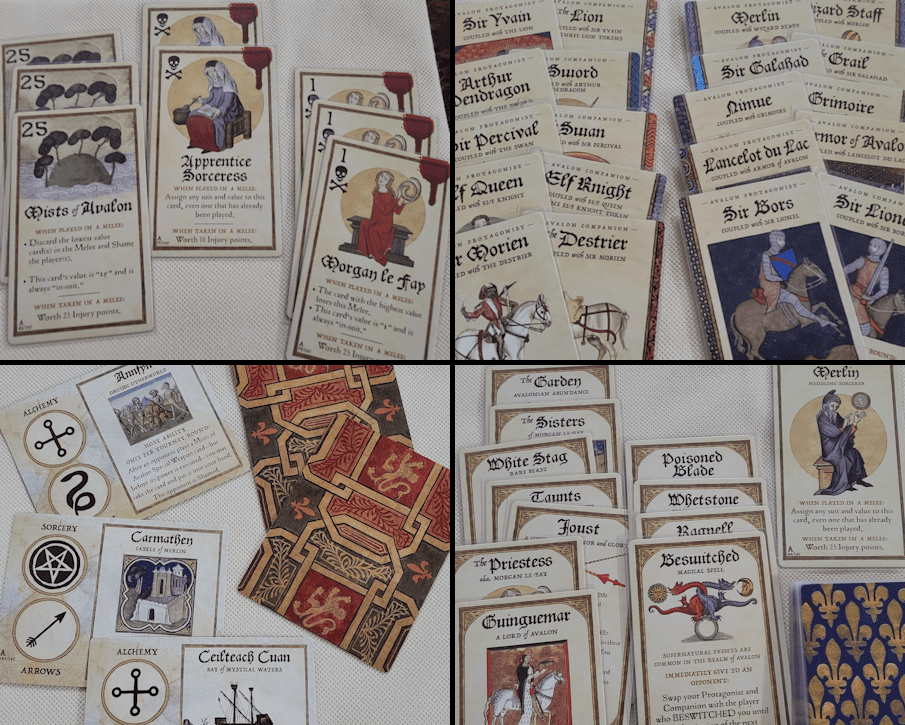
The basic game-play does not change. That said, Avalon does have some optional rules:
- Fey Changelings – each round, players pass three cards to a neighbor (alternating left and right each round).
- Enhanced Alchemy – Alchemy cards can be used to lead at any time (even if that player has cards of other suits in their hand) and can be used to follow at any time (even if that player has cards of the lead suit in their hand).
- Swift End – at the start of a melee, if one or more players have no weapon cards in hand, the round ends immediately. Players discard their hands and assess their weapon hit piles.
Injuries are calculated much as in Camelot: standard weapon cards are worth one injury if they are not poisonous, two if they are. Apprentice Sorceress cards are worth two injuries; Mists of Avalon and Morgana le Fey cards are worth five.
Otherwise, things are just as they were in Camelot.
Combining the Sets
There are no issues with combining the sets. When doing so, the Weapons deck from Avalon should be used because of how some new elements interact with the Merlin card. Everything else is used.
Is it Worth it?
Both of these sets are wonderful products. Game play is both fun and tense! The tension often comes from the fact that not all of the cards are used each round. In traditional trick-taking games, the whole deck is dealt out; keeping track of which cards have been played is vital to success. This is vital here as well, but so is recognizing that many cards are outside the players’ hands and will not show up.
Add in the various special powers and players have a lot to keep in mind! In my experience it is not overwhelming, though (even in six-player games). Players are engaged, checking their hands and counting the potential damage in each melee. Thanks to sorcerer cards (Camelot) and Alchemy cards (Avalon), a bad hand is not devoid of interesting tactical and strategic choices.
The production is quite good. All of the cards are Tarot-sized with evocative, old-style artwork. I will say that having the Weapons deck Tarot-sized is overkill. I believe the cards would be easier to shuffle and hold in your hand if they had been standard poker-size cards, or perhaps the 65×100mm cards used in games like 7 Wonders. If you sleeve your cards, shuffling is not as big an issue.
If you have to choose only one set, I recommend Avalon. From a game-play perspective (i.e., Characters and Godsend cards), these sets are equally fun. Where Avalon inches ahead is in the rulebook. The rules are organized better, with the steps for playing a melee and a round explained far more clearly. The detail virtually eliminates edge cases. I have also found the optional rules to greatly enhance the experience. These are standard rules in every game I have played since acquiring the set.
If you do decide to get both sets, all of the components needed for combined play will fit into one box (even with sleeved cards). The other box will have nothing more than the extra Weapons deck and Health cards.


Of course, you could keep everything together and play The Chaos of Battle variant!
The Chaos of Battle
This variant can be used with lower player counts, but was specifically conceived with 7-8 players in mind. It uses the combined sets (plus extra Health card sets). Each round, a new location card is used, which determines the two suits to add to the base Avalon deck from the Camelot deck (for a total of 113 cards). Players can never get more than one Godsend card each round. Otherwise, things play as normal.
I have not yet been able to get a group together to do this. I cannot tell you how much I want to!


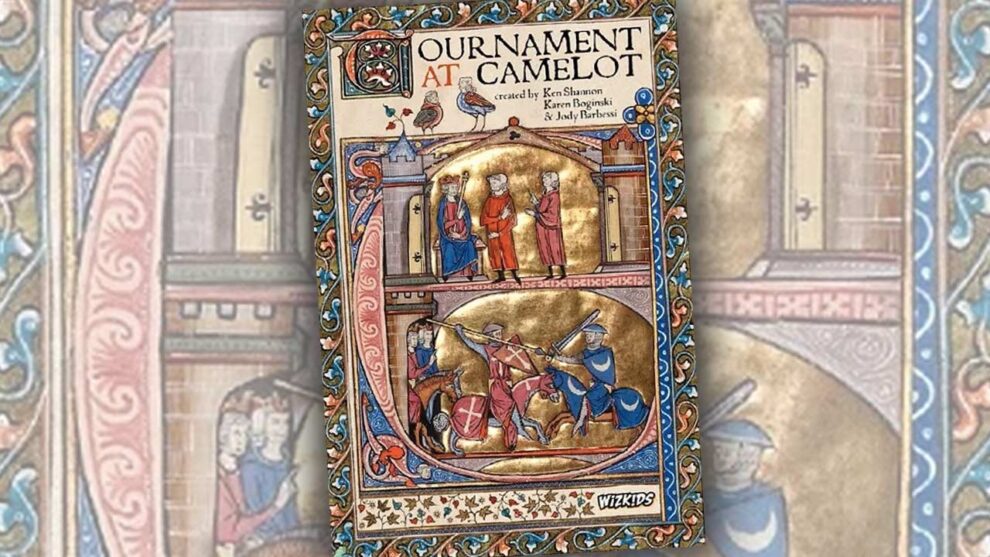



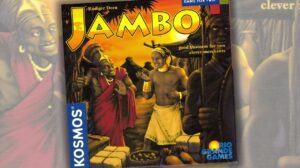





Nicely done. My main concern about these titles is that the artwork makes the cards look a little too busy. Have you found that to be the case in the games you’ve played?
No, not really. The artwork is a plus from me (very cool and very old school). The only thing I think (as I said above) is that the cards that are in your hand all the time can get tiresome to hold at the Tarot-card size. But I get why that choice was made.